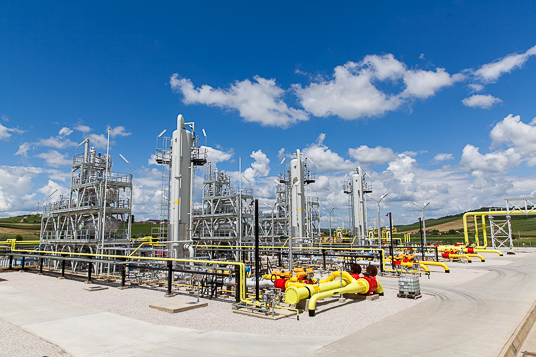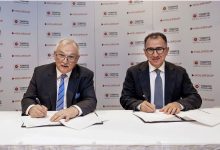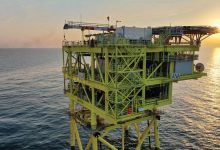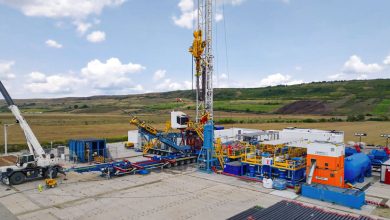Onshore natural gas discovery assessed at usd 4 billion
Romgaz has recently inaugurated the largest onshore natural gas field discovered in Romania in the past 30 years. According to estimates, the deposit located on the Caragele platform in CA Rosetti locality, Buzau County, reportedly contains 27 billion cubic meters of natural gas, which means that its exploitation would ensure Romania’s consumption for two and a half years.
Discovered last year, the deposit has a length of 35 kilometres and it was found at a depth between 1,500 and 5,000 meters.
Experts estimate that it contains between 25 and 27 billion cubic meters of natural gas, being surpassed only by the Neptun deposit, discovered in 2012 in the Black Sea area by ExxonMobil and OMV Petrom and which has between 42 and 84 billion cubic meters of natural gas. The first announcement regarding the discovery of the deposit was made in June last year.
INVESTMENTS OF EUR 180 MILLION
As announced by Romgaz officials, the Caragele deposit is currently under development, and the investments carried out so far amount to EUR 40 million.
Thus, the first three wells have been drilled, being into operation following the installation of the drying station and the gas measuring station.
This year three wells will be drilled that could prove that the deposit’s reserves are higher than the current estimates.
Romgaz representatives said the deposit is to enter production in 2019, after an additional investment of EUR 140 million.
PRODUCTION TESTS, ENCOURAGING FROM THE VERY BEGINNING
Romgaz has identified this deposit in the RG 06 Muntenia Northeast block, where it carries out oil operations as sole holder of the Concession Agreement for Exploration-Development-Exploitation. The discovery is located in the north-eastern sector of the Moesian Platform.
The completed initial production tests at the first two exploration wells, 55 Damianca and 77 Rosetti, confirmed a significant accumulation of hydrocarbons in Jurassic limestone tanks on a range of over 120 meters at depths of more than 4,000 meters.
The results following the flow tests (DST) on 7 mm and 9 mm nozzles predicted a daily output ranging from 1,400 to 2,200 boe/well.
The contingent resource, based on drilling data and tests including well geophysics, extracted mechanical cores and fluids, and from trap dimensioning by 3D seismic data, is estimated to be between 150 and 170 million boe.
The results obtained in the first two wells have confirmed that the decision to use 3D seismicity in the opening exploration for deep geological objectives was correct.
“Romgaz is a strong presence on the regional market, and given the intensified competition for access to resources, our strategy aims to strengthen our company’s position on the market by identifying new opportunities for growth and diversification and by improving our company’s performance. The current market conditions call for a careful analysis of the investment strategy of the oil and gas companies. For Romgaz, the increase in the portfolio of resources and hydrocarbon reserves, as well as the development of storage facilities, remain a priority. In a continuously changing market, the investment in exploration, exploitation and storage is important for the company’s development. The results show that the investment programme and the exploration strategy have achieved the objectives, which creates very good prospects for the continuation of the exploration programmes in Romania,” Virgil Metea, General Manager of Romgaz, said at the end of June 2016.
Attending the inauguration of the discovery, Energy Minister Toma Petcu said the Caragele gas field is assessed at minimum USD 4 billion, representing a discovery enabling Romania to become a major player on the gas market in the region and not only.
“Romgaz has revealed the largest discovery that a Romanian company, Romgaz, has made on gas reserves in Romania. It is a reserve that stores, by first estimates, 30 billion cubic meters and the exploitation capacity is of 27 billion cubic meters. On the average annual consumption, it would probably be enough for three years, had this deposit be the only one exploited. It’s a deposit rated to at least USD 4 billion. It is a discovery that has gone past the exploration phase, we are now in the exploitation phase, we are already delivering gas to the system,” the Energy Minister said.
“This is a discovery that shows Romanian economy’s great potential and the prospect that Romania becomes a hub in the gas field, to be an important player on the gas market in the region and not only,” the minister said.
THE LARGEST DEPOSITS DISCOVERED SO FAR
Romania’s certain, proven gas reserves have fallen by more than 26% during 2014-2016, from 150 to 101.37 billion cubic meters.
Following the discovery and entry into operation of Caragele deposit, Romania will be able to join the list of gas exporters.
In recent years, several discoveries have been announced by the companies that have concessions in Romania, the deposits entry in operation will turn our country into an exporter of natural gas.
- In 2012, OMV Petrom and ExxonMobil announced the discovery of an important natural gas deposit with the Domino-1 well in the deep-sea area of the Black Sea Neptun block. The well has been placed 170 kilometres from the shore, in waters with a depth of about 1,000 meters. The drilling operations started at the end of 2011. The gas reserves in that area allegedly range from 42 to 84 billion cubic meters of natural gas, but no decision has yet been made regarding the deposit’s entry in operation.
- In 2015, OMV Petrom and ExxonMobil announced the discovery of a new gas deposit, also in the Black Sea. A third exploration well drilled, Pelican South-1, has reportedly identified a new gas accumulation, the second success after the 2012 discovery.
- Also in 2015, near the block explored by OMV Petrom and ExxonMobil, the consortium made up by LukoilOverseas, PanAtlantic and Romgaz confirmed a 30 billion cubic meter natural gas deposit. In October, work was completed on the LIRA-1X exploration well, which led to the discovery of this important deposit in the EX-30 Trident block.
- In February 2017, Black Sea Oil & Gas (BSOG) announced that it has discovered in the Black Sea natural gas reserves estimated at 10-20 billion cubic meters. Gas extraction is expected to begin in 2019. In the first phase, one billion cubic meters of gas will be extracted per year, and in the next few years the production will gradually increase to four billion cubic meters. BSOG announced in April 2017 the awarding of a drilling contract for the drilling of two offshore exploration wells located in the XV Midia block, in the Shallow Water Zone of the Black Sea Romanian sector, the local marine drilling service provider being GSP Offshore.







